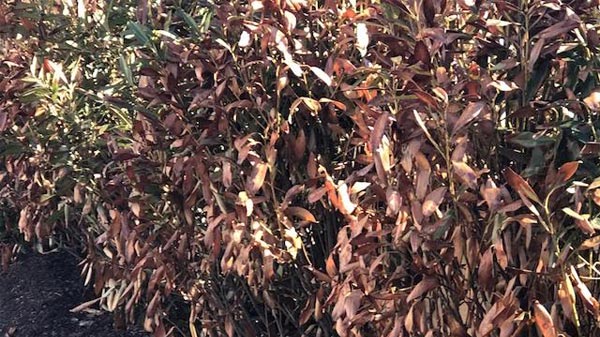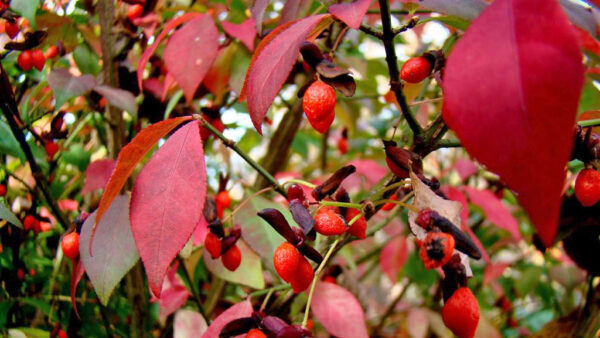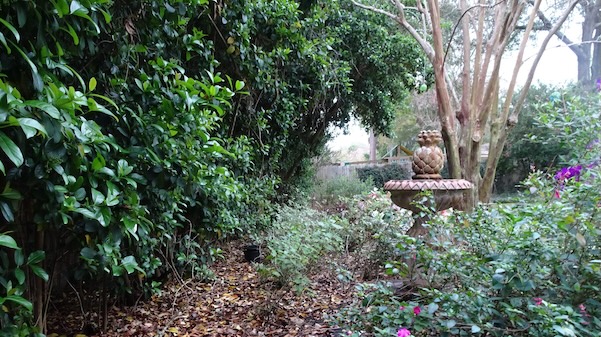The Cold, Hard Truth About Winter Damage

When spring gardeners begin their happy work this year, they may notice some browning on their hardy evergreen plants. Rhododendrons may have dry, brown leaves. Needles on conifers may look rust or brown-colored. Shiny holly plants look dull and droopy. This is winter burn, and it’s due to the very long, cold winter we’ve had – and especially to these late-season storms.
Thankfully spring is here, if in name only. Our plants have suffered enough! When the ground freezes, plants just can’t move water from their roots to their thirsty leaves. The result, as the University of Maryland Extension puts it, is that “leaves curl and droop, then brown from the tips and margins, giving the leaves a scorched appearance. In many cases damage occurs during the winter months, but symptoms appear in the spring as the plant begins to emerge from the winter dormant period and move into the spring growth phase.” That means that spring gardeners are usually the ones who notice and must treat winter burn.
Fortunately, winter burn is both preventable and, in most cases, treatable. As we’ve noted previously on our blog, an anti-desiccant spray can go a long way in protecting plants.
Anti-desiccant products help evergreen trees and shrubs hold onto their moisture throughout the winter months. Anti-desiccant sprays basically seal off the pores in these plants, preventing the moisture from escaping. This can help save the plants we love in Connecticut, like boxwood, rhododendron, holly, and laurel.
Anti-desiccants need to be applied just before winter – that is, before the ground freezes and while the plants are still full of the water they need to survive. The spray is essentially a polymer, which puts a glossy coating on the leaves and prevents them from releasing moisture and wilting.
While these sprays can save your plants, one spray is not usually enough. Apart from anti-desiccant products simply not lasting through the winter, these late-season freezes and snow falls often cause damage. Warm spells, or “false spring” will encourage growth, then a subsequent freeze will kill it. A second anti-desiccant treatment will protect the plant.
The Missouri Botanical Garden offers additional tips to prevent winter burn:
- Water through early winter – one inch per week from late fall through early winter may provide adequate moisture to improve your shrub’s survival.
- Break the wind – we don’t love the look of burlap in your garden, but it’s a great wind barrier for fragile plants. It’s especially helpful if you can’t do anti-desiccant for any reason, or if your plants are likely to be exposed to salt water.
- Mulch – covering the roots, mulch prevents too much moisture from escaping during the winter months.
Of course, there are other ways plants can be damaged in a long, cold winter like the one we’ve had. Not all of it is true “winter burn,” but it’s harmful nonetheless.
- Salt burn can scorch leaves and kill buds. The runoff from salt and de-icers in melted snow can also change soil composition and cause it to become compacted, which can cause problems for growing plants. To avoid salt burn, avoid piling salt-tainted snow near your plants, particularly near roots. If it can’t be avoided, water generously to flush the area of salt once the spring thaw hits. You may also want to consider replacing salt and de-icers with more environmentally-friendly sand or sawdust.
- Frost damage can occur when plants are pruned late in the season, and new growth appears just as frost hits. Additional damage can occur if a frost occurs in spring, after warmer weather has encouraged new buds. New growth will turn brown or black, and eventually wither and fall off. More extensive damage can be pruned away. Most plants will survive.
- Broken or damaged branches can occur as the result of heavy wind, ice or snow. In these cases, it’s best to wait until the end of the season to remove the damaged limbs, unless they present a hazard. In many cases, you may need a tree professional to handle the removal.
In every case, your best bet for healthy plants that weather the winter is to choose trees and shrubs that thrive in Connecticut’s temperate climate. A hardy plant will always have improved odds for success. Taking preventative measures like applying anti-desiccant will also help, as will ongoing maintenance, from fertilization to regular, well-timed pruning.
If you do have damaged plants, please contact us right away with any concerns. Damaged shrubs and trees are always more susceptible to disease and infestation, so we may want to take additional measures to care for them before the warm weather arrives.
As always, if you have any questions about the care of your garden’s plants, feel free to contact me.
Latest Posts
The Best Deer-Resistant Flowers, Trees, and Shrubs for Connecticut Gardens
If you love gardening but struggle with deer destroying your plants, you’re not alone. Many homeowners in the northeast face the challenge of keeping their…
Invasive Plants in Connecticut: Why do they matter and what can we do about them?
The recent wildfires in California were horrific and devastating to homeowners and the economy. Many of the factors leading to this tragedy were beyond prevention:…
Watch Our Video: Reducing Mosquitoes with In2Care Traps
Nobody likes mosquitoes. They’re kind of the worst, aren’t they? Besides the annoying, itchy bites, they can also carry diseases like Dengue and Zika. But…
Maintain a Beautiful, Healthy Lawn Free Of Pests
Contact us today for a free consultation and find out how Connecticut Green can make your lawn healthier and more vibrant!
